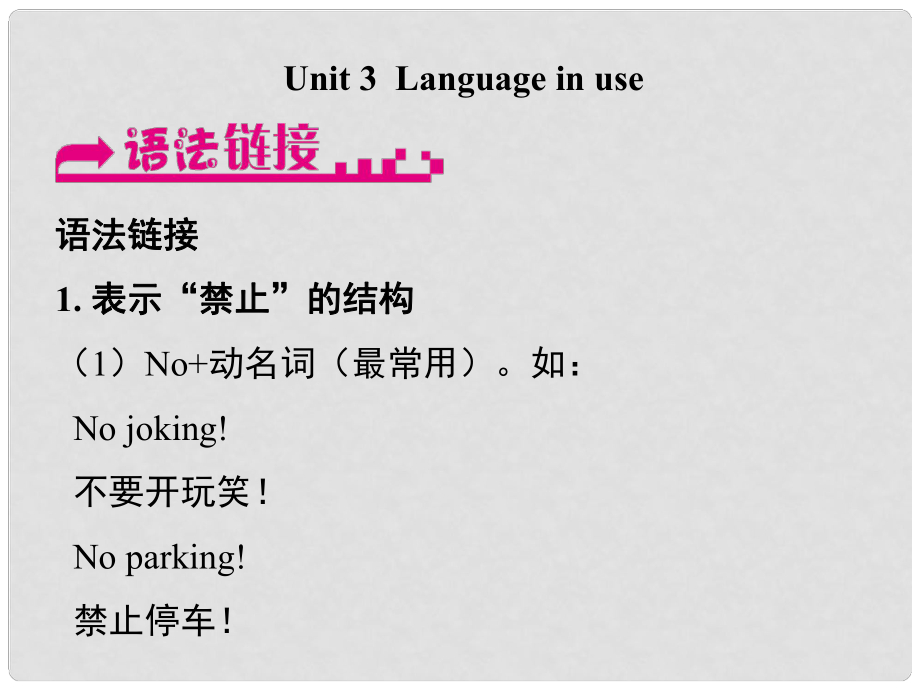《浙江省嘉興市秀洲區(qū)九年級(jí)英語(yǔ)上冊(cè) Module 5 Unit 3 Language in use課件 (新版)外研版》由會(huì)員分享�����,可在線閱讀,更多相關(guān)《浙江省嘉興市秀洲區(qū)九年級(jí)英語(yǔ)上冊(cè) Module 5 Unit 3 Language in use課件 (新版)外研版(18頁(yè)珍藏版)》請(qǐng)?jiān)谘b配圖網(wǎng)上搜索�。
1、Unit 3 Language in use語(yǔ)法鏈接語(yǔ)法鏈接1. 表示表示“禁止禁止”的結(jié)構(gòu)的結(jié)構(gòu)(1)No+動(dòng)名詞(最常用)��。如: No joking! 不要開玩笑���! No parking! 禁止停車��! (2)No+名詞����。如: No photos. 請(qǐng)勿拍照��。 No food and drinks. 請(qǐng)勿飲食���。 (3)祈使句�����。如: Dont swim here! 不要在這里游泳�! Never shout! 絕不要喊叫����! Dont turn left! 不要向左拐���! Dont make any noise. 不要吵鬧。 Keep off the grass. 請(qǐng)勿踐踏草坪�。 (4)用mustn
2、t表示“禁止”��。如: You mustnt touch anything! 禁止觸摸任何東西�����! (5)用be not allowed to do sth.���。如: You arent allowed to smoke here. 你不準(zhǔn)在這兒吸煙�。 2. if引導(dǎo)的條件狀語(yǔ)從句(一)引導(dǎo)的條件狀語(yǔ)從句(一) (1)if從句的構(gòu)成 條件狀語(yǔ)從句表示主句動(dòng)作發(fā)生的條件�����,在初中階段常由if(如果)引導(dǎo)�。本模塊重點(diǎn)學(xué)習(xí)的是“if條件狀語(yǔ)從句+祈使句”這一結(jié)構(gòu)��。如: Please call me if he is at home. 假如他在家的話�����,請(qǐng)給我打電話。 (2)主從句的位置 從句可以位于主句之前��,
3��、也可以位于主句之后�。不過(guò)從句在前時(shí),主從句之間必須用逗號(hào)隔開���。如: Please tell me if he comes back. =If he comes back, please tell me. 如果他回來(lái)了�,請(qǐng)告訴我一聲����。 (3)時(shí)態(tài) 在由if引導(dǎo)的條件狀語(yǔ)從句中,如果主句為祈使句���,從句通常用一般現(xiàn)在時(shí)�。如: Put up your hand if you have any question to ask 如果你有任何問(wèn)題想要問(wèn)的話��,請(qǐng)舉手�����。 (4)if的“兩面性” if既可引導(dǎo)條件狀語(yǔ)從句(此時(shí)意為“如果”),也可引導(dǎo)賓語(yǔ)從句(此時(shí)意為“是否”)���。如: Stay in if it
4�、is snowy tomorrow. 如果明天下雪就待在家里���。 I dont know if the train has arrived. 我不知道火車是否已經(jīng)到了�����?�!驹掝}呈現(xiàn)】【話題呈現(xiàn)】 本模塊圍繞“Museums”展開話題��,要求學(xué)生能夠描寫自己喜愛(ài)的博物館�����,并正確使用代詞it����,they和副詞there以及說(shuō)明在博物館內(nèi)要遵守的各項(xiàng)規(guī)章制度�。【佳句薈萃】【佳句薈萃】 What a wonderful museum! 多么精彩的博物館呀�����! No shouting, please!Its against the rules. 請(qǐng)不要喧嘩�����!這是違反規(guī)定的�。 Stop! Dont cross th
5、at rope! 停下�����!不要越過(guò)那條粗繩����! No entry. 禁止入內(nèi)。 No photos. 請(qǐng)勿拍照��。 There certainly are a lot of rules in this museum. 在這個(gè)博物館當(dāng)然有許多規(guī)定���。 We must keep quiet in it. 我們必須在此保持安靜�。 In most museums, there is no shouting and no running, and you must not touch anything. 在大多數(shù)博物館�,禁止喧嘩與跑步�,而且你不能觸碰任何東西����。 If you want answers to al
6、l your questions about science, this is the right place for you. 如果你想要所有關(guān)于科學(xué)問(wèn)題的答案��,這對(duì)你來(lái)說(shuō)是個(gè)好地方�����?�!緦懽魅蝿?wù)】【寫作任務(wù)】 請(qǐng)根據(jù)提示���,寫一篇約80詞的短文介紹一下你最喜愛(ài)的博物館上海博物館���。 內(nèi)容提示:位于人民廣場(chǎng)中心,占地4 000平方米��;藏有許多古書畫�、青銅器;有許多游客參觀��。Beginning開篇點(diǎn)題開篇點(diǎn)題 My favourite museum is 1 . Shanghai Museum 【寫作指導(dǎo)寫作指導(dǎo)】 這是談?wù)搮⒂^博物館等公共場(chǎng)所及相關(guān)規(guī)則的文章�,用第三人稱�,一般現(xiàn)在時(shí)寫作����。 in t
7���、he centre of Body詳細(xì)描述詳細(xì)描述2. It is located Peoples Square. It covers an area of . There are so many .3. When you are visiting the museum, dont shout, .Ending提出建議提出建議If you have a 4 to go there, you will have a 5 . 4,000 square metresancient bookskeep quietchancegood time【自主創(chuàng)作】【自主創(chuàng)作】 【范文展示】【范文展示】 My f
8����、avourite museum is Shanghai Museum. Shanghai Museum is located in the centre of Peoples Square. It covers an area of 4,000 square metres. There are so many ancient books, paintings and bronze wares in it. Its just like a huge book to tell you the history of China. People from all over the country li
9�、ke to go there to see a large number of antiquities with their own eyes. When youre visiting the museum, do not shout, keep quiet. If you have a chance to go there, youll have a good time. 【升格點(diǎn)撥】 1. 文章中cover an area of., a large number of, with ones own eyes, have a chance to do等短語(yǔ)的使用,為文章添彩不少����。 2. 文章的最后提出了建議,給讀者親切之感�。
 浙江省嘉興市秀洲區(qū)九年級(jí)英語(yǔ)上冊(cè) Module 5 Unit 3 Language in use課件 (新版)外研版
浙江省嘉興市秀洲區(qū)九年級(jí)英語(yǔ)上冊(cè) Module 5 Unit 3 Language in use課件 (新版)外研版

